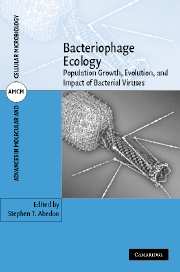Book contents
- Frontmatter
- Contents
- About the cover
- List of contributors
- Foreword by Bruce R. Levin
- Preface
- 1 Phages, ecology, evolution
- Part I Phage ecology
- 2 Bacteriophages: models for exploring basic principles of ecology
- 3 Phage population growth: constraints, games, adaptation
- 4 Impact of spatial structure on phage population growth
- 5 Contribution of lysogeny, pseudolysogeny, and starvation to phage ecology
- Part II Phage evolutionary biology
- Part III Phage ecology in environments
- Part IV Modeling phage ecology
- Index
- Plate section
4 - Impact of spatial structure on phage population growth
from Part I - Phage ecology
Published online by Cambridge University Press: 29 September 2009
- Frontmatter
- Contents
- About the cover
- List of contributors
- Foreword by Bruce R. Levin
- Preface
- 1 Phages, ecology, evolution
- Part I Phage ecology
- 2 Bacteriophages: models for exploring basic principles of ecology
- 3 Phage population growth: constraints, games, adaptation
- 4 Impact of spatial structure on phage population growth
- 5 Contribution of lysogeny, pseudolysogeny, and starvation to phage ecology
- Part II Phage evolutionary biology
- Part III Phage ecology in environments
- Part IV Modeling phage ecology
- Index
- Plate section
Summary
INTRODUCTION
Limitations on bacterial mobility may be described in terms of an environment's spatial structure: the degree to which diffusion, motility, and mixing are hindered or selectively enhanced. A large fraction of bacteria live within environments that possess spatial structure — within biofilms, within soil, or when growing in or on the tissues of plants and animals. This spatial structure also affects phage movement and therefore phage impact on bacterial populations. Gaining an understanding of phage growth within spatially structured environments consequently is pertinent to developing a comprehensive understanding of phage ecology. Here we employ a working assumption that phage population growth in the laboratory in semisolid media (as within phage plaques) represents one approximation of phage population growth within spatially structured environments in the wild. We thus present an introduction to phage plaque formation with the hope that at least some of our discussion may be relevant to future studies of in situ phage ecology, such as spatially fine-grained analyses of phage population expansion within biofilms.
See Chapter 16 for methods in modeling phage plaque formation, Abedon and Yin (in press) for a complementary review of phage plaque formation, Chapter 2 for phage growth given spatial structure as introduced in the guise of metapopulations, Chapter 3 for consideration of phage population growth as it occurs within non-spatially structured environments, and Chapter 11 for discussion of the phage ecology of soils.
- Type
- Chapter
- Information
- Bacteriophage EcologyPopulation Growth, Evolution, and Impact of Bacterial Viruses, pp. 94 - 113Publisher: Cambridge University PressPrint publication year: 2008
- 4
- Cited by



